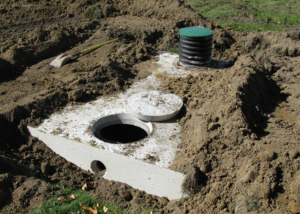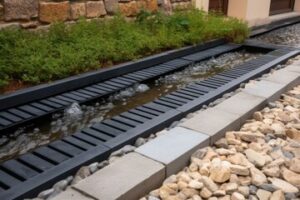When you purchase a home with a septic tank, it is important to have the system inspected. If not maintained properly, this type of sewage system can cause problems that impact the environment. Click the https://www.septictankarmadale.com.au/ to learn more.
A septic tank is a watertight container made of concrete or plastic. Solid materials settle at the bottom, forming sludge, while grease and other lighter materials float on top, forming scum. Liquid wastewater (effluent) exits the septic tank through a distribution box and goes to the drain field area.

All the wastewater from your toilets, showers, bathtubs, sinks, washing machines, and dishwasher (called wastewater) drains through a pipe into the septic tank. The septic tank is a large, underground, watertight container made of concrete or plastic, with a cover that should be secured and well-maintained. Solid materials in the wastewater settle to the bottom and form sludge, while oils and fats float to the top and form scum. Anaerobic bacteria in the septic tank feed on the organic materials and break them down into a liquid substance known as effluent. The sludge and scum are periodically removed from the septic tank by truck or vacuum. The effluent leaves the septic tank through the septic tank outlet and flows into a septic tank drain field or leach field.
The septic tank is designed to hold wastewater until the bacteria have had time to break it down and remove most of the organic material. The liquid wastewater then flows through a filter near the septic tank outlet and into a perforated pipe that leads to the drain field. The septic tank and the drain field work together to treat wastewater. The treated water seeps into the ground where it is absorbed by the soil, or through evaporation or transpiration by plants. It may also enter groundwater or surface water via a leaching process.
Septic tanks are a practical solution in areas where there is not enough space for a conventional sewer system. However, they require regular maintenance and can be dangerous if the tank leaks into a home or well. You can minimize your risk of problems by carefully considering what you put down the drains, using septic-friendly detergents and cleaners, and hiring a licensed plumber to perform routine inspections and repairs.
If you are thinking of buying a property with a septic system, consider asking the seller to have the septic tank inspected before closing. This will ensure the system is working properly and does not have any problems that could lead to sewage contamination of the groundwater or the home’s well water supply.
Sludge
In a septic tank, density differences cause the sewage to separate into three layers. The top layer is scum, consisting of materials that float on water like grease and oils. The middle layer is a liquid and the bottom layer is sludge, which is denser than water. Bacteria in the sludge layer decompose these organic materials and eventually liquify them into the liquid layer. This process is known as septic tank digestion and occurs naturally, without the need for chemical additives.
The septic tank sludge needs to be pumped out from time to time in order to prevent a buildup. There are a few different ways to determine how often this should be done: using a do-it-yourself tool, estimating the depth of the sludge with a visual assessment, or asking a professional to perform an inspection. Whatever method is used, it is important to have the septic tank pumped at least once every three to four years.
When septic tanks are neglected, the sludge layer can build up to excessive levels. When this happens, it takes longer for the bacteria to digest the sludge. The bacteria will also be less efficient at the digestion process, and this can lead to the release of methane and other noxious gases.
Septic tank sludge is pumped out of the tank and taken to either a landfill or a septic tank treatment plant. Alternatively, the sludge can be sold to independent, for-profit companies that specialize in septage dumping. Septage dumping sites are regulated by local and state environmental agencies to ensure that the septic tank sludge does not seep into groundwater or pollute the surrounding environment.
It is important to keep in mind that while chemical and biological additives may claim that they can aid or accelerate the septic tank digestion process, it is best to allow the bacteria to do their work naturally. The septic system should never be overloaded with solid wastes, as this can block the drain field and prevent sewage from filtering down into soil and recharging groundwater. Keeping up with routine maintenance and getting the septic tank pumped when necessary can avoid these problems.
Effluent
The septic tank is a large dual-chambered buried container made of concrete, fiberglass or polyethylene. Wastewater flows into the tank where it undergoes a process called settling. Heavy solids, like sediment and sludge sink to the bottom of the tank where they are partially decomposed by bacterial activity. Substances lighter than water, like greases, oils and fats float to the top of the tank where they are digested by aerobic bacteria. The liquid layer in the middle, known as effluent, leaves the septic tank and flows into a buried drain field where it is dispersed into soil.
When a homeowner uses the toilets, showers, laundry and garbage disposals in their home, wastewater flows through pipes to the septic tank where it undergoes a treatment process. As the wastewater moves through the septic system, it generates gases, such as hydrogen sulfide that smells similar to rotten eggs. To prevent a build-up of pressure that could stop or reverse the flow of sewage, a gas vent is fitted on the tank lid and vented to the outside air.
Bacteria in the septic tank break down the wastewater contaminants, including disease-causing pathogens and nutrients such as nitrogen and phosphorus. As they do so, the bacteria produce byproducts such as ammonia and volatile organic compounds that must be released into the air. To release these byproducts, a second vent in the tank lid is fitted with a charcoal filter to reduce odors.
As the septic tank fills up with sludge and scum, it must be pumped periodically. When a homeowner fails to pump the tank, solids can enter the drain field where they will clog and expose people and animals to disease-causing organisms.
Because septic systems are located underground, they are often out of sight and mind. However, they must be inspected regularly to ensure that the tank is working properly. During the inspection, a technician will check for cracks or leaks in the tank and pipe connections, determine how much sludge has accumulated and pump the septic tank as needed. The drain field also requires routine care to avoid problems such as clogs and soil erosion. To protect the drain field, homeowners should not build in the area or plant anything that might root into or pierce the septic tank or pipe connections.
Drain Field
A septic tank’s drain field, also known as a leach field, takes the liquid waste that floats to the top of the septic tank and disperses it into soil. A typical drain field consists of a series of downward-sloped, underground pipes with gravel that spread wastewater throughout the soil.
The septic tank’s biological processes work to clean the dirty water before it is returned to the groundwater system. The sewage that flows into the tank is weighted by its density, which causes the heavy masses to sink as sludge while the lighter masses rise as scum. The septic tank’s anaerobic digestion process further breaks down these masses to remove harmful impurities and make the wastewater safe for return to the soil.
After septic tank sludge and scum have been separated from the wastewater, the liquid effluent exits the tank through its outlet. This is then pumped to the drain field. The drain field is a network of perforated pipes laid in gravel-filled trenches underground. These trenches are then covered with soil, allowing the effluent to trickle through the gravel and into the surrounding soil. As the wastewater percolates through the soil, it is naturally cleaned of harmful bacteria and excessive nutrients.
Taking care of your septic tank and drain field is easy with proper maintenance. You can help prevent problems by using only septic-safe toilet paper, never pouring solids down your drains and not parking vehicles on the drainfield. It’s important to have your septic tank inspected and pumped regularly by professionals.
If you notice a foul odor, a wet or soggy area over your septic tank or drain field, slow-to-drain kitchen or bathroom drains or sewage backups inside your home, these are all signs that your septic system is overloaded and in need of repair. Trying to diagnose and fix your own septic system problems may result in damage to your septic tank, leach field or the surrounding soil. If you suspect a problem with your septic system, always contact the expert team at Mr. Rooter Plumbing for a professional assessment and any required services.
